As we first reported earlier this year:
While plans for an eight-story hotel to rise up to 85 feet in height upon the eastern three-quarters of the Central SoMa Shell Station site on the southwest corner of Fifth and Folsom were in the works, those plans appear to have been abandoned.
At the same time, plans for an even bigger development have been massed by TCA Architects for the Fifth and Folsom Investors LLC.
And as newly envisioned [and rendered below], a 16-story building would rise up to 160 feet in height on the 300 5th Street site, with 130 apartments over 1,000 square feet of ground floor retail space and a request to waive the site’s existing 85-foot height limit – which wasn’t changed per San Francisco’s Central SoMa Plan – based on California’s Density Bonus Law.
But as with the proposed tower to rise up to 294 feet in height on the northwest corner of Harrison and Hawthorne, Planning has challenged the project team’s calculation of the bonus allowed per the aforementioned bonus law and its application to the development as proposed.
At the heart of the looming battle is a legislative change attached to the City’s Central SoMa Plan, a Plan which allows for additional height and density within the neighborhood but also restricts full lot coverage developments, a restriction which affects the base calculation of a conforming development and its subsequent bonus potential.
And despite Planning’s preliminary feedback on the project as envisioned, and challenge, the project team proceeding with their plans for a 160-foot-tall project, formally responding: “The Project Sponsor does not support any legislative changes that reduce the allowable residential density proposed for this project or any others within the Central SoMa SUD” and is “not prepared [to reduce their calculation of the allowable density bonus] at this time.”
We’ll keep you posted and plugged-in.
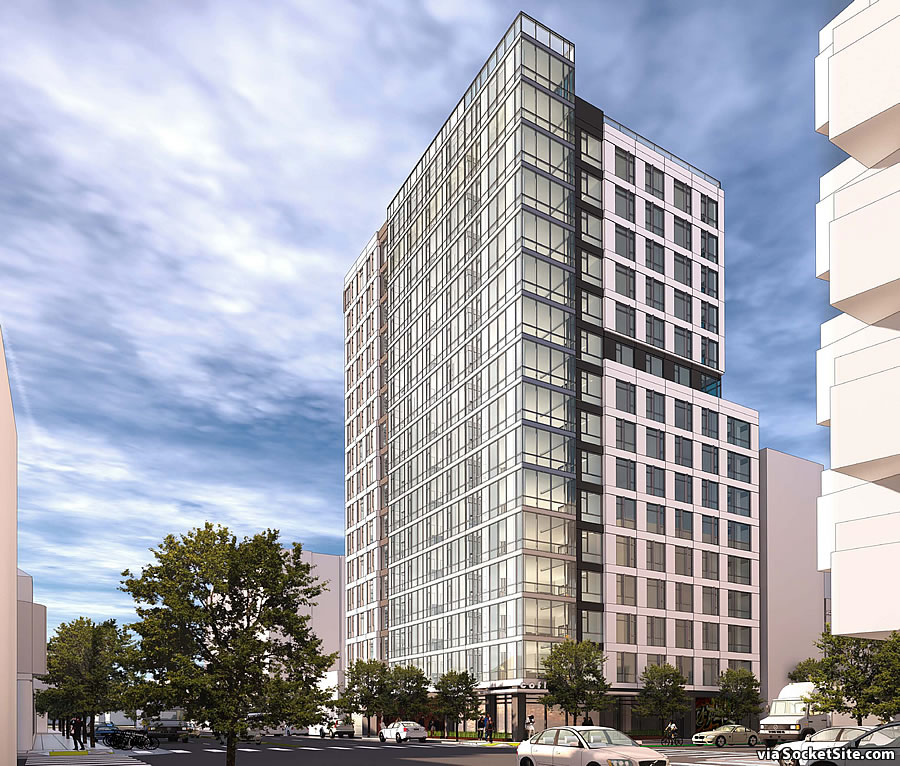
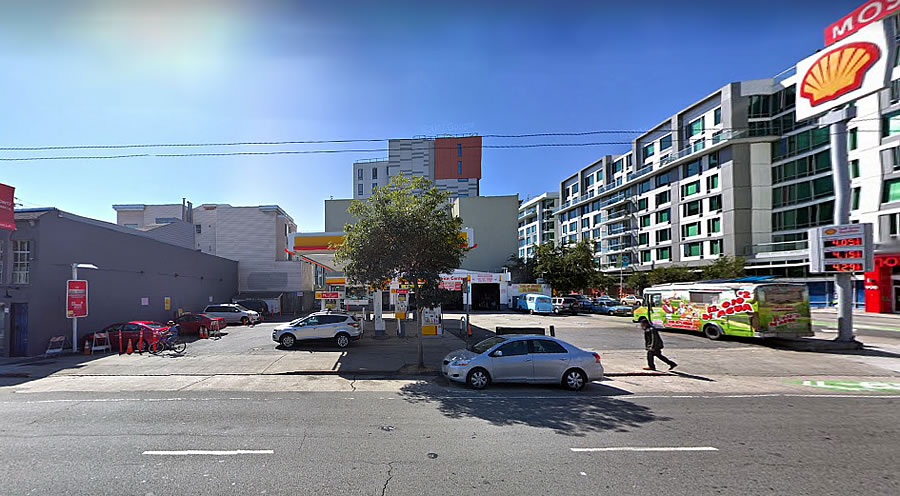
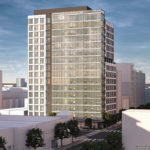
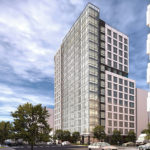
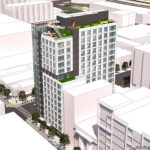
Hopefully this is rejected as proposed. Give developers an inch and they will try to take a foot. Sure, raise the height limit but, in exchange, disallow full lot coverage. Limit coverage to 80% or so and use that space for greening and widening sidewalks. This, built as proposed, will be a foreboding behemoth that adds nothing to the streetscape.
Why would you be against the developer given little housing we have in our pipeline vs demand? One one had we want market to respond to supply and demand, and here’s a response to the demand. On the other hand, your comment says “give them an inch and they will take a foot” seems out of touch with the housing reality in SF.
100%
we need the building capacity. theres already enough green space. we have the most of in city in the US. we need housing.
I think it has been pointed out that most of the green space is not in SOMA. That said I’m not opposed to more density here, but if access to green space is a priority then we should be building high rises surrounding golden gate park.
As much as I love ‘greening’ I don’t think you’d have to try hard to add anything to the streetscape—being it’d replace a gas station with sidewalk trees, housing, retail, fewer curb-cuts, and ultimately way, way more pedestrian activity.
I would, however, love to see a design that attempts to step outside of this one-step-removed-from-massing design style that seems to have become so comfortable for architects to hack together.
All very valid considerations as to why lot coverage is better planning over shrubbery. And, don’t forget the “it might actually get built” factor as favoring the added density.
The developer is absolutely right on this one — on at least a couple of legal grounds.
1. For the Planning Dept. to disallow 100% lot coverage only to the “Base Studies” of a State Bonus Density Law housing development for the purposes of determining the “Bonus Project” density is patently illegal as it is singling out such projects and applying special/detrimental development standards to them. This clearly runs counter to the intent of the State Law.
2. Additionally, Senator Skinner’s SB330 just passed both the Assembly and Senate on 9/06/19 and Governor Newsom has stated that he will sign it into law. Once this occurs, the Planning Dept. will not be allowed (per their recently-published new policy in Planning Director Bulletin #6) — on these grounds alone — to impose this new policy regarding proposed housing projects; as SB330 explicitly makes this illegal.
The Planning Dept./ City should back off of this one, because they’re, once again, going to lose — and expose the taxpayers to considerable $ liability (like Supervisor Ronen did with the so-called “historic laundromat” at 2918 Mission) if they continue to thwart the developer in contradistinction to State Law.
And, seriously, at the end of the day, everyone has been complaining about the”jobs-housing imbalance” in the decade-in-the-making Central Soma Plan. Accordingly, don’t we want to encourage as much housing development as possible? Come on folks — what Planning is asserting is both illegal and bad policy.
I think this is an excellent project for the downtown of a major city in need of housing. Apparently your only reason to oppose it is that an evil developer wants to do it. It seems to be very much what we want to encourage by offering a “density bonus” . . . that is, density.
“Greening” at 5th and Folsom??? What kind of rat infested wasteland are you imagining for the useless 20% of the lot that you propose? No, it is just fine to use this whole entire lot for housing and retail that will absolutely add to the streetscape. “Adds nothing…” Sheesh, even a blank wall would be more pedestrian friendly than curb cuts for the gas station.
I’m glad I don’t have to live at that intersection.
Wider sidewalks do nothing but encourage homeless encampments
We should definitely add vehicles lanes to the Embarcadero and get rid of all the parks then… /s
Get real.
Why would we want to build more housing in a transit rich area anyway?
Because a ton of people work in the area but *do not* live close to whatever that transit connects to. For example, I commute 45min a day to that very intersection. My rent would be 50% higher if lived in SF, or next to a CALTRAIN stop. ($3600/month for a 1Bdr is a unaffordable for most people.) So it would be great to have a LOT more housing in Central SOMA.
MoreHousingPlease: I believe the previous comment was at attempt at sarcasm.
(Mine was a sarcastic comment)
Good looking project. This kind of housing density should be built a block away from the subway station at 4th & Folsom.
@Dave (Seattle dude) I’m not sure what your talking about, 130+ families and individuals living on what used to be a decrepit gas station will do a lot to improve the existing streetscape conditions (in my humble opinion).
Only so many precious lots left in downtown SF and its wasted on soulless architecture like this. This looks about as ugly as the avalon in mission bay which is a master class on how to make blocky, dull architecture that brings nothing to a neighborhood. bringing housing doesn’t always equal bringing life to a neighborhood.
and this isn’t an argument against density, i’d take 1000 ft tall apartment building over this if it was design tastefully.
It’s frustrating that the Planning Department, on its own, with no apparent pressure from supervisors or community groups (there has yet to even be a public hearing on this) is trying to redefine the calculation of density bonus units to get less housing.
Do they understand we’re in a housing shortage? Do they know San Francisco is on track to miss Mayor Breed’s goal of 5,000 new units per year by a lot, and even to produce fewer absolute units than Oakland, a poorer city with half our population?
From what I understand, the developer’s interpretation appears to be correct, and it’s the planning staff whose interpretation doesn’t comply with state law. But even if Planning were technically correct, why on earth would they be extending so much effort to push for fewer homes? It’s frankly offensive.
All my friends who live near this proposal (and the other one at Harrison and Hawthorne) are supportive of the full-sized project. Central SoMa needs more people living there to support 7 day a week retail. Much of the neighborhood feels shut down on weekends, and residential density is key to changing that. But here comes the planning bureaucracy striking out on their own, acting like it’s their job to guard against too much housing during a shortage. You couldn’t possibly find clearer evidence of a need for change in the department.
Exactly!
Well said! Planning is one (of many) reasons for our crisis. I’m still waiting for a Mayor to do anything.
We are not in a housing shortage.
We are in an *affordable* housing shortage.
And housing is increasingly not “affordable” because there is a shortage of it.
See how that works?
If there is scarcity of something that everybody needs then the price goes up.
The underlying solution to housing affordability — along with the affordability of anything else — is to create an abundance of it.
Once you are on that path, then those that still unable to afford housing can be helped with efficient/targeted assistance.
There’s also a shortage of people to build said new housing, so the price of labor goes up, resulting in it costing $400-$600/sf…i.e. no longer “affordable”.
And the more you try to build, the greater the rise in the cost of labor, and the less affordable anything built will be.
See how THAT works ??
So you’re saying that prices will drop if we remove housing?
The dirty little secret of the construction industry is that very little is spent on R&D compared to other industries, and that’s (one reason) why construction worker productivity has increased at a rate slower than U.S. worker productivity overall.
There is not a “shortage of people to build said new housing” — there is a shortage of “construction labor” — along with a surplus of under-employed and under-trained people (e.g. in West Oakland, Richmond, Vallejo, Antioch, etc.)
Accordingly, the solution is to tap into this resource, incentivize and increase the training of this population and, thereby, increase the construction labor workforce — with good-paying union construction jobs!
This is what creative entrepreneurs, like Rick Holiday with his modular housing factory (Factory OS) at Mare Island in Vallejo, are doing. More private/public coordination should be encouraged in this regard.
It’ll expand the construction workforce, increase employment (especially for vulnerable populations / for those most in need of solid, gainful and esteem-enhancing employment), increase housing production, mitigate rising housing costs, increase the health of the overall economy and move increasing numbers of people into the middle class.
That’s how things could work in the absence of do-nothing, NIMBY-naysayers.
We need more kids in the trades. Everyone is expected to get a massive loan to go to college, but that’s not for everyone. A union job in the trades is far more valuable than some useless degree that puts you in the hole and results in nothing more than a gig economy job that pays less than minimum wage when expenses are accounted for. The SFUSD should have a track for high school students to learn trade skills. They could also have classes in teaching project and construction management.
UPDATE: Another Development Appears to Have Been Abandoned